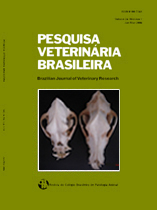 |
|
|
|
Year 2007 - Volume 27, Number 05
|

|
Aspectos clinicopatológicos de 620 casos neurológicos de cinomose em cães, 215-220
|
ABSTRACT.- Silva M.C., Fighera R.A., Brum J.S., Graça D.L., Kommers G.D., Irigoyen L.F. & Barros C.S.L. 2007. [Clinicopathological features in 620 neurological cases of canine distemper.] Aspectos clinicopatológicos de 620 casos neurológicos de cinomose em cães. Pesquisa Veterinária Brasileira 27(5):215-220. Departamento de Patologia, Universidade Federal de Santa Maria, 97105-900 Santa Maria, RS, Brazil. E-mail: claudioslbarros@uol.com.br
The files of 5,361 necropsies performed in dogs in the Veterinary Pathology Laboratory of the Federal University of Santa Maria during 1965-2006 were reviewed in search of cases of canine distemper. Six hundred and eighty three cases (12.7%) of the disease were found, 620 of which had neurological signs. From those 620, the following data on each case were retrieved: age, clinical signs, histopathology and concomitance or not of another disease. Age groups were classified as puppies (up to 1 year of age), adults (from 1 to 9 years) and aged (from 10 years on). In 565 out of the 620 (91.1%) neurological cases of canine distemper, histopathological brain changes were observed and in 554 of those 565 the age was registered in the files with following age group distribution: 45.9% of puppies, 51.4% of adults, and 2.7% of aged dogs. Neurological clinical signs encompassed a large spectrum of motor, postural and behavioral disturbances which could occur together or individually. Most frequent clinical signs were myoclonus (38.4%), motor incoordination (25.0%), seizures (18.5%), and paraplegia (13.4%). In 98.4% of the 565 dogs with histopathological changes in the brain demyelination, non-suppurative encephalitis or a combination of these two were found. Intranuclear eosinophilic inclusion bodies were observed in different brain cells of 343 of the 565 dogs with histopathological changes. In 170 (49.6%) the cellular type bearing the inclusions was not mentioned in the file and in the remaining cases the inclusions were seen in astrocytes (94.8% of the cases), neurons (3.5%), oligodendrocytes (1.1%), and ependyma cells (0.6%). Taking in consideration the type of lesions and the age groups, cases with combined demyelination and non-suppurative encephalitis occurred in 40.0% of the puppies, 51.2% of the adult dogs and 72.7% of the aged dogs. Demyelination alone occurred in 48.4% of the puppies, 41.3% of the adults and in 35.7% of the aged dogs. Non-suppurative encephalitis alone occurred 11.6% of the puppies, 7.5% of the adults and in 7.1% of the aged dogs.
|
| |
|
|
| |
|
 |